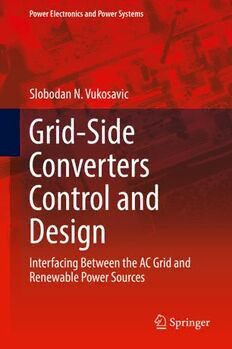
Grid-Side Converters Control and Design PDF
Preview Grid-Side Converters Control and Design
Power Electronics and Power Systems Slobodan N. Vukosavic Grid-Side Converters Control and Design Interfacing Between the AC Grid and Renewable Power Sources Power Electronics and Power Systems SeriesEditors JoeH.Chow,RensselaerPolytechnicInstitute,Troy,NewYork,USA AlexM.Stankovic,TuftsUniversity,Medford,Massachusetts,USA DavidJ.Hill,UniversityofHongKong,PokFuLam,HongKong The Power Electronics and Power Systems Series encompasses power electronics, electric power restructuring, and holistic coverage of power systems. The Series comprises advanced textbooks, state-of-the-art titles, research monographs, profes- sionalbooks,andreferenceworksrelatedtotheareasofelectricpowertransmission and distribution, energy markets and regulation, electronic devices, electric machinesanddrives,computationaltechniques,andpowerconvertersandinverters. The Series features leading international scholars and researchers within authored books and edited compilations. All titles are peer reviewed prior to publication to ensure the highest quality content. To inquire about contributing to the Power ElectronicsandPowerSystemsSeries,pleasecontactDr.JoeChow,Administrative Dean of the College of Engineering and Professor of Electrical, Computer and SystemsEngineering,RensselaerPolytechnicInstitute,JonssonEngineeringCenter, Office7012,1108thStreet,Troy,NYUSA,518-276-6374,[email protected]. Moreinformationaboutthisseriesathttp://www.springer.com/series/6403 Slobodan N. Vukosavic Grid-Side Converters Control and Design Interfacing Between the AC Grid and Renewable Power Sources SlobodanN.Vukosavic DepartmentofElectricalEngineering UniversityofBelgrade Belgrade,Serbia SerbianAcademyofSciencesandArts Belgrade,Serbia ISSN2196-3185 ISSN2196-3193 (electronic) PowerElectronicsandPowerSystems ISBN978-3-319-73277-0 ISBN978-3-319-73278-7 (eBook) https://doi.org/10.1007/978-3-319-73278-7 LibraryofCongressControlNumber:2018932557 ©SpringerInternationalPublishingAG,partofSpringerNature2018 Thisworkissubjecttocopyright.AllrightsarereservedbythePublisher,whetherthewholeorpart of the material is concerned, specifically the rights of translation, reprinting, reuse of illustrations, recitation,broadcasting,reproductiononmicrofilmsorinanyotherphysicalway,andtransmissionor informationstorageandretrieval,electronicadaptation,computersoftware,orbysimilarordissimilar methodologynowknownorhereafterdeveloped. The use of general descriptive names, registered names, trademarks, service marks, etc. in this publication does not imply, even in the absence of a specific statement, that such names are exempt fromtherelevantprotectivelawsandregulationsandthereforefreeforgeneraluse. Thepublisher,theauthorsandtheeditorsaresafetoassumethattheadviceandinformationinthisbook arebelievedtobetrueandaccurateatthedateofpublication.Neitherthepublishernortheauthorsorthe editorsgiveawarranty,expressorimplied,withrespecttothematerialcontainedhereinorforanyerrors oromissionsthatmayhavebeenmade.Thepublisherremainsneutralwithregardtojurisdictionalclaims inpublishedmapsandinstitutionalaffiliations. Printedonacid-freepaper ThisSpringerimprintispublishedbytheregisteredcompanySpringerInternationalPublishingAGpartof SpringerNature. Theregisteredcompanyaddressis:Gewerbestrasse11,6330Cham,Switzerland To my parents, Anka and Nikota Vukosavić, whose love and guidance remain with me. Preface This textbook is intended for undergraduate students at final years of electrical engineering. It is also recommended for students preparing capstone project where theyneedtounderstand,model,supply,control,andspecifygrid-sideconvertersin micro-grids, distribution grids, and residential, commercial, and industrial applica- tions.Atthesametime,itcanbeusedasavaluablereferenceforotherengineering disciplinesinvolvedwithsmartgrids,renewablesources,andenergyaccumulation. It is also suggested to postgraduates and engineers aspired to development of electronicallycontrolledproduction,transmission,distribution,anduseofelectrical energy. Unlike majority of textbooks on this subject, this book requires a rather limited background. Wherever possible, an effort is made to provide the text approachable to students and engineers in engineering disciplines other than electrical. Thescopeofthistextbookistoprovidebasicknowledgeandskillsindesigning and controlling the grid-side inverters, in the electronically controlled static power converters that are becoming a key part in smart grids, as well as in new, power electronics-based systems for production, transmission, distribution, and use of electricalenergy.Basicengineeringconsiderationsareusedtointroducethesalient featuresofgrid-sidepowerconvertersinintuitivemanner,easytorecallandrepeat. Thebookpreparesthereadertocomprehendthekeypropertiesandrolesofgrid-side converters,toanalyzetheirsteady-stateandtransientcharacteristics,toobtainbasic notionsontheirdesignandcontrol,toevaluatetheeffectofelectronicallycontrolled loads in ac grids, to understand the changes introduced by replacing traditional synchronous machines by source-side converters, to consider the effects of an increased number of power electronic devices on power system controls and pro- tections,andtoforeseethefuturedevelopmentsandrelatedrequirements. Discussion,analysis,andknowledgedevelopmentongrid-sidepowerconverters andtheintroductionofbasicskillsaresuitedfortheelectricalengineeringstudents in their final year of undergraduate studies. Required background includes mathe- matics, physics, and introductory courses of power electronics, control theory, and powerengineering.Thetextbookismadeaccessibletoreaderswithouttheadvanced vii viii Preface background in the subject matters. An attempt is made to prepare a self-contained book.Thebookcomprisesquestionsandanswersandsolvedproblemswhereverthe learningprocessrequiresanoverview.Thechapterscompriseanappropriatesetof exercises, problems, and design tasks, arranged to reinstate and use the relevant knowledge. Wherever it is needed, the book includes extended reinstatements and explanationsoftherequiredskillandprerequisites.Theapproachandmethodused inthistextbookcomesfromthe22yearsofauthor’sexperienceinteachingelectrical engineeringattheUniversityofBelgrade. Readership This book is primarily suited for the electrical engineering undergraduates in their finalyear.Itisalsosuggestedtopostgraduatesofallengineeringdisciplinesthatplan to major in power electronics, renewables, smart grids, and other areas focused on developinganovel,powerelectronics-basedproduction,transmission,distribution, anduseofelectricalenergy.Thebookisalsorecommendedtostudentsthatprepare capstoneprojectinoneoftheareas.Thebookmayalsoserveasavaluablereference for engineers in other engineering disciplines that are involved with the subject matter. Prerequisites Required background includes basic mathematics, physics, engineering fundamen- tals,aswellasintroductorycoursesofpowerelectronics,controltheory,andpower engineering. The textbook is made accessible to readers without the advanced backgroundinthesedisciplines.Itissuitedforthestudentsofelectricalengineering on their last year of undergraduate studies. Discussion, analysis, and knowledge development on grid-side power converters and the introduction of basic skills are also suited for other engineering students on their postgraduate studies. Individual chapterscomprisequestionsandanswers,aswellassolvedproblemswhereveritis requiredbythelearningprocess.Whereveritisneeded,thebookincludesextended reinstatementsandexplanationsoftherequiredskillandprerequisites. Objectives (cid:129) Usingbasicengineeringconsiderationstointroduceprinciplesofenergyconver- sionwithinbasictopologiesofgrid-sideconverters (cid:129) Providingrelevantknowledgeandskillsinpulsewidthmodulationoftwo-level and multilevel converters. Comprehending the PWM noise, the current ripple, andthenecessarypassivefilters Preface ix (cid:129) Acquiringskillsinanalyzinganddesigningstationaryframe,synchronousframe, and resonant current controllers. Comprehending the controller capability to suppress the input disturbances and the voltage disturbances, to provide a well- damped,overshoot-freestepresponse,andtosecurethedesiredrobustness (cid:129) Studyingtheprocessofthefeedbackacquisition,understandingthebasiccurrent sensors,recallingthesamplingprocessandthesamplingtheorem,designinganti- aliasingfilters,andintroducingoversampling,decimation,andone-PWM-period averaging (cid:129) Masteringtheskillsofmodelingdiscrete-timecurrentcontrolsystems,designing the controller structure, compensating the transport delays, and deriving the optimumfeedbackgains (cid:129) Analyzingtheneedtosuppressthelow-orderharmonics,comprehendingtherole ofthevoltage-disturbancerejection ofthecurrentcontroller,introductionofthe active resistance feedback, and designing the controller which encompasses the activeresistancefeedback (cid:129) Studyingandapprehendingthecontroloftheactiveandreactivepowerinjected intotheacgridbymeansofd-axisandq-axiscurrent (cid:129) Understanding control of the dc-bus voltage between the two back-to-back inverters used in a wind-power converter set which includes the generator-side inverterandthegrid-sideconverter (cid:129) Analyzingthesynchronizationofthegrid-sideconverterbymeansofthephase- lockedloop.Theimpactofthephase-lockedlooponthepowertransientscaused bythegridfrequencychange.Controlmeansforthegrid-sidepowerconverters whichemulatethetransientresponseofconventionalsynchronousmachine (cid:129) Understandinginjectionofparasiticdc-biasintoacgrids.Studyofsensitivityof distribution transformers to the bias. The sensors for detection of small dc-bias voltages embedded into ac voltages. Active suppression of the dc-bias voltages bymeansofgrid-sideconvertersequippedwiththedc-biassensorsandthebias- suppressionalgorithm Teaching Approach (cid:129) Theemphasisisgiventothesystem view,explainingexternalcharacteristics of grid-sideconverters.Thebasicfunctionalityandcontrolsareofthemaininterest. Designandconstructionaspectsareofsecondaryimportance. (cid:129) Where needed, introductory parts of teaching units comprise repetition of the requiredbackgroundwhichisappliedthroughsolvedproblems. (cid:129) Mathematicsisreducedtoanecessaryminimum. (cid:129) The main goal is development and use of mathematical models and transfer functionsofgrid-sideconverters.Atthesametime,thefocusiskeptonphysical insightofthepowerconversionprocesses. x Preface (cid:129) Although the hardware design is out of the scope, some most relevant concepts and design skills are introduced and explained. The book also explains some secondary effects, indicating the cases and conditions where the secondary phenomenacannotbeneglected. Field of Application This book discusses power electronics, power systems, smart grids, and other applicationofelectronicallycontrolledstaticpowerconvertersinproduction,trans- mission, and distribution of electrical energy. Analysis and considerations are focusedonbasicfunctionality,topologies,controls,andstaticanddynamiccharac- teristics of power electronic systems used in conjunction with micro-grids, smart grids, renewable sources, static transformers, bus converters, load-side converters, accumulation devices, static VAR compensators, and other similar applications. Contemporarytrendsinpowersystems includetheintroductionofdcvoltages and currents in transmission and distribution of electrical energy, the integration of advanced communication networks that enable remote commands and controls, distributed generation of electrical energy, distributed accumulation resources, and new,onlinenegotiatedenergytransactionsthatcontributetothebenefitofboththe utilitiesandtheclients. Design, control, and use of power electronic systems in electrical power appli- cationsrequirestheknowledgeandskillsinpowerconvertertopologies,pulsewidth modulation algorithms, acquisition and filtering of the feedback signals, designing andtuningofthedigitalcurrentcontroller,controllingtheactiveandreactivepower, suppressing the low-frequency line harmonics, measuring and suppressing the parasitic dc-bias in ac grids, using the phase-locked loop to synchronize the grid- sideconverterstotheacgridvoltages,andsettinguptheconvertercontrolssoasto mimic the behavior of conventional synchronous machines. This book comprises considerations,analysis,studies,andexamplesthatfacilitatetheengineeringefforts indesignatedarea. Belgrade,Serbia SlobodanN.Vukosavic
